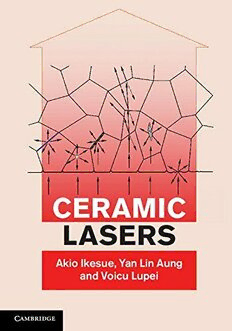
Ceramic Lasers PDF
Preview Ceramic Lasers
more information - www.cambridge.org/9780521114080 CERAMIC LASERS Untilrecently,ceramicmaterialswereconsideredunsuitableforopticsduetothenumerous scatteringsources,suchasgrainboundariesandresidualpores.However,inthe1990sthe technologytogenerateacoherentbeamfromceramicmaterialswasdeveloped,andhighly efficient laser oscillation was realized. In the future, the technology derived from the development of the ceramic laser could be used to develop new functional passive and activeoptics. Co-authoredbyoneofthepioneersofthisfield,thebookdescribesthefabricationtech- nology and theoretical characterization of ceramic material properties. It describes novel typesofsolidlasersandotheropticsusingceramicmaterialstodemonstratetheapplication of ceramic gain media in the generation of coherent beams and light amplification. This is an invaluable guide for physicists, materials scientists and engineers working on laser ceramics. akio ikesue isthePresidentofWorld-Lab.Co.,Ltd.Heisalsoanexecutivescientistat SCHOTTAG,Germany,andaninvitedprofessoratENSCP(EcoleNationaleSupe´rieure deChimiedeParis). yan lin aung is a Senior Researcher at World-Lab. Co., Ltd. His research focuses on opto-ceramics. voicu lupei is a Professor at the National Institute for Laser, Plasma and Radiation PhysicsinBucharest,Romania.Hisresearchinterestsareinphotonicmaterials,quantum electronicsprocessesindopedlasermaterials,andapplicationsofsolid-statelasers. CERAMIC LASERS AKIO IKESUE World-Lab.Co.,Ltd,Japan YAN LIN AUNG World-Lab.Co.,Ltd,Japan VOICU LUPEI NationalInstituteforLaser,PlasmaandRadiationPhysics, Romania cambridge university press Cambridge,NewYork,Melbourne,Madrid,CapeTown, Singapore,Sa˜oPaulo,Delhi,MexicoCity CambridgeUniversityPress TheEdinburghBuilding,CambridgeCB28RU,UK PublishedintheUnitedStatesofAmericabyCambridgeUniversityPress,NewYork www.cambridge.org Informationonthistitle:www.cambridge.org/9780521114080 (cid:2)c A.Ikesue,Y.L.Aung,V.Lupei2013 Thispublicationisincopyright.Subjecttostatutoryexception andtotheprovisionsofrelevantcollectivelicensingagreements, noreproductionofanypartmaytakeplacewithoutthewritten permissionofCambridgeUniversityPress. Firstpublished2013 PrintedandboundintheUnitedKingdombytheMPGBooksGroup AcatalogrecordforthispublicationisavailablefromtheBritishLibrary LibraryofCongressCataloginginPublicationdata Ikesue,Akio,1958– Ceramiclasermaterials/authors,AkioIkesue,YanLinAung,VoicuLupei. pages cm Includesindex. ISBN978-0-521-11408-0(hardback) 1.Lasermaterials. 2.Ceramicmaterials. I.Title. TA1677.I44 2013 621.36(cid:3)6–dc23 2012042974 ISBN978-0-521-11408-0Hardback CambridgeUniversityPresshasnoresponsibilityforthepersistenceor accuracyofURLsforexternalorthird-partyinternetwebsitesreferredto inthispublication,anddoesnotguaranteethatanycontentonsuch websitesis,orwillremain,accurateorappropriate. Contents Preface pageix Acknowledgement xii 1 Introduction 1 1.1 Researchbackground 1 1.2 Technicalproblemsofmelt-growthsinglecrystals 2 1.3 Technicalproblemsofceramics 7 1.4 Purposeofthisresearch 11 1.5 Outlineofthebook 12 References 16 2 Solid-statelaserprocessesandactivematerials 18 2.1 Interactionofquantumsystemswithelectromagneticradiation (radiationabsorptionandemissionprocessesinquantumsystems) 18 2.2 Solid-statelasers 25 2.3 Theflowofexcitationinsidethelasermaterial 63 2.4 Laseremissionprocesses 67 2.5 Thespatialdistributionofthede-excitationprocesses 82 2.6 Thermalfieldinsidethepumpedlasermaterialandthermaleffects 85 2.7 Performancescalingofsolid-statelasers 91 2.8 Thelasermaterial 93 References 115 3 Experimentaltechnique:powdercharacteristicsandthesynthesisofoptical gradeceramics,effectsofsinteringaids 121 3.1 Introduction 121 3.2 MicrostructureandopticalcharacteristicsofNd:YAGprocessedbyHIP (hotisostaticpressing) 142 References 158 4 Synthesisofpolycrystallineceramiclasers(RE-dopedsesquioxides) 160 4.1 Currentstatusofsinglecrystaltechnology 160 4.2 Requirementsforsesquioxideceramiclasers 162 v vi Contents 4.3 Synthesisofopticalgradesesquioxideceramics 169 4.4 Opticalqualityandlaserperformance 176 References 185 5 SynthesisofRE(Nd)heavilydopedYAGceramics 187 5.1 ProductionofheavilydopedNd:YAGandlasingcharacteristics 188 5.2 Effectofimpurity(Si)onNdsolid-meltinYAGceramics 204 References 218 6 Opticalscatteringcentersinpolycrystallineceramics 219 6.1 Introduction 219 6.2 Experimentalprocedure 220 6.3 Results 223 6.4 Discussion 234 6.5 Summary 239 References 240 7 Advancedtechnologiesinceramics(composite,fiber,singlecrystalby sinteringmethod,etc.) 241 7.1 Compositetechnology 243 7.2 Ceramicfiberlaser 252 7.3 Singlecrystalceramicsproducedbysintering 255 7.4 Summary 265 References 265 8 CurrentR&Dstatusofceramiclasersworldwide 267 8.1 Garnetsystemmaterials 268 8.2 Perovskitesystemmaterials 273 8.3 Non-oxidesystem(II–VIcompound)materials 275 8.4 Fluoridesystemmaterials 277 8.5 Applicationsinthefieldsofbiotechnologyandmedicaltechnology 279 8.6 Highintensitylasersforengineignition 282 8.7 Investigationofsolid-statelasersassolarpumplasers 285 References 288 9 Thefutureofceramictechnology 290 References 298 10 Highresolutionopticalspectroscopyandemissiondecayoflaserceramics 300 10.1 Structuralcharacterizationofdopedceramicsbyopticalspectroscopy 301 10.2 Thequantumstatesofthedopingions 321 10.3 Radiativeandnon-radiativede-excitationprocesses 345 10.4 Distributionofthedopingionsinceramics 358 10.5 Conversionofexcitationindopedceramics 360 10.6 Conclusionsfromhighresolutionopticalspectroscopyoflaserceramics 370 References 372 Contents vii 11 Ceramiclasers 386 11.1 Pumpingschemes 386 11.2 Radiativeandnon-radiativeprocessesinceramics 392 11.3 Ceramiclasermaterialsandcomponents 401 11.4 Ceramiclasers 403 11.5 Concludingremarks:thestateoftheartanddirectionsofdevelopment ofceramiclasers 424 References 427 Index 442
